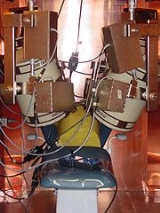
Lung counter
Encyclopedia

Ionizing radiation
Ionizing radiation is radiation composed of particles that individually have sufficient energy to remove an electron from an atom or molecule. This ionization produces free radicals, which are atoms or molecules containing unpaired electrons...
emitted from radioactive material that has been inhaled by a person and is sufficiently insoluble as to remain in the lung
Lung
The lung is the essential respiration organ in many air-breathing animals, including most tetrapods, a few fish and a few snails. In mammals and the more complex life forms, the two lungs are located near the backbone on either side of the heart...
for weeks, months or years.
Often, such a system is housed in a low background counting chamber whose thick walls will be made of low-background steel
Low-background steel
Low-background steel is steel produced prior to the end of World War II. Following Atomic bombing of Hiroshima and Nagasaki, and the nuclear weapons testing during the Cold War, world background radiation levels increased substantially...
(~20 cm thick) and will be lined with ~1 cm of lead, then perhaps thin layers of cadmium, or tin, with a final layer of copper. The purpose of the lead, cadmium (or tin) and copper is to reduce the background in the low energy region of a gamma spectrum
Gamma ray
Gamma radiation, also known as gamma rays or hyphenated as gamma-rays and denoted as γ, is electromagnetic radiation of high frequency . Gamma rays are usually naturally produced on Earth by decay of high energy states in atomic nuclei...
(typically less than 200 keV)
Calibration
As a lung counter is primarily measuring radioactive materials that emit low energy gamma rayGamma ray
Gamma radiation, also known as gamma rays or hyphenated as gamma-rays and denoted as γ, is electromagnetic radiation of high frequency . Gamma rays are usually naturally produced on Earth by decay of high energy states in atomic nuclei...
s or x-ray
X-ray
X-radiation is a form of electromagnetic radiation. X-rays have a wavelength in the range of 0.01 to 10 nanometers, corresponding to frequencies in the range 30 petahertz to 30 exahertz and energies in the range 120 eV to 120 keV. They are shorter in wavelength than UV rays and longer than gamma...
s, the phantom
Imaging phantom
Imaging phantoms, or simply "phantoms", are specially designed objects that are scanned or imaged in the field of medical imaging to evaluate, analyze, and tune the performance of various imaging devices. These objects are more readily available and provide more consistent results than the use of...
used to calibrate the system must be anthropometric. An example of such a phantom is the Lawrence Livermore National Laboratory
Lawrence Livermore National Laboratory
The Lawrence Livermore National Laboratory , just outside Livermore, California, is a Federally Funded Research and Development Center founded by the University of California in 1952...
Torso Phantom.

